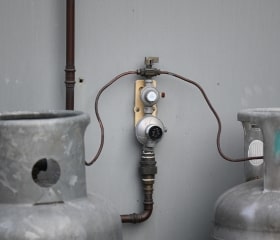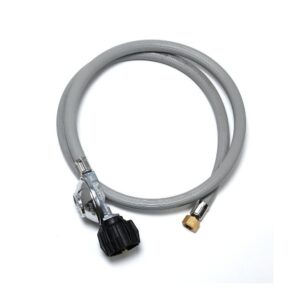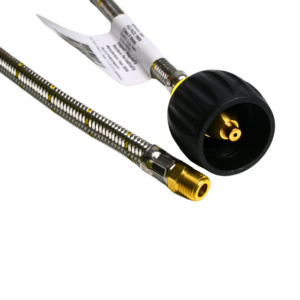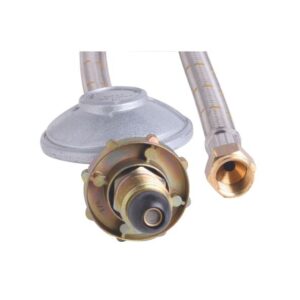Articles
April 8, 2025
Gas regulators have a variety of different applications, types and designs. It’s extremely important to understand the difference before selecting and working with one for your next project. In our complete guide, we’ll explore what differentiates gas regulators from each other, and how to find the right regulator for you.
Gas regulators are essential devices that control the pressure and flow of gas from a high-pressure source to a safe and usable level for appliances. They ensure consistent performance, safety, and efficiency in residential, commercial, and industrial gas systems.
By automatically adjusting gas pressure, regulators prevent overpressure issues, reduce gas waste, and maintain stable appliance operation. They are used in applications such as BBQs, gas stoves, LPG cylinders, industrial machinery, and more. They serve as a critical component in gas distribution and usage.
For more information, check out our complete guide to how gas regulators work.
No, not all gas regulators are the same. There are two basic types of gas regulators: single-stage and dual-stage. Within these categories, other differing factors include size, material, pressure rating and more.
Here’s an overview of the differences between gas regulators, and what makes them most suitable for various applications.

Group shot of different types of regulators.
The differences between gas regulators primarily come down to function, application, and gas compatibility. Below we go dive deeper into the aspects that need to be considered when choosing the right gas regulator for your next project.
There are two types of gas regulators: single stage and dual stage.
The main difference between the two is in their characteristics and how they regulate and control gas pressure.
A single stage regulator has only one pressure reducing chamber. This means the gas enters the regulator from the gas source before the diaphragm and spring system work together to adjust the pressure. Then the regulated gas exits to the application in use.
Single stage regulators are for applications in which a constant outlet pressure is not vital, where an operator can monitor and re-adjust pressure, or where an inlet pressure is stable.
On the other hand, a dual stage regulator has two pressure reducing phases within the same chamber. It reduces pressure in two controlled steps. This refines gas pressure further leading to more stable and reliable output pressure.
Advantage of a dual stage regulator include more accurate pressure control and multiple safety valves to handle over-pressured conditions. Dual stage regulators are recommended for applications that require a constant outlet pressure for the life of a gas cylinder.
Gas regulators are used for a wide range of different applications. They are frequently required for household appliances including BBQs, gas stoves, gas water heaters, heating systems and more.
Gas regulators are also used in industrial environments where precise gas control is required. Some uses include welding and cutting torches, HVAC and boiler systems, manufacturing and industrial processing, laboratories and medical facilities, and more.
Gas regulators are also frequently used for applications like:
Different gas regulators are suitable for different tasks. For example, gas regulators are designed to work with particular kinds of gases. If regulators will be in contact with corrosive gases, you’ll need to choose a regulator made of an appropriate, resistant material.
The pressure rating on a gas regulator ensures that there is a safe amount of gas flow going to the appliance in use. Using a regulator with an incorrect pressure rating can lead to wear and tear and decrease the life of the regulator.
Each appliance requires a specific amount of gas, so knowing how the right pressure each appliance needs using a pressure gauge is important.
Low-Pressure (1.1 kPa for Natural Gas, 2.75 kPa for LPG) is generally used for residential BBQs, heaters, and cooktops. Medium-Pressure (5–10 kPa) is used in some commercial kitchen equipment. And high pressure (100–1500 kPa or more) is needed for industrial applications, such as a HVAC technician using an Oxyset brazing system which requires the combined use of MAP- Pro and oxygen.
Over-pressurisation can lead to hose or appliance failure, increasing the risk of gas leaks and fire hazards. Under-pressurisation may cause incomplete combustion, leading to carbon monoxide buildup.
Before installing any gas regulator, it is important to understand that they must comply with AS/NZS 5601.1 gas safety standards in Australia and New Zealand. Using a regulator with the correct pressure rating ensures compliance with local codes and manufacturer guidelines and instructions.
Gas regulators come in various sizes based on flow rate, pressure capacity, and connection type. The right size depends on the application, gas type, and appliance demand. Regulators are rated by the amount of gas they can handle.
Low-flow regulators (up to 50 MJ/h) are used for small gas appliances, like a single BBQ or heater.
Medium-flow regulators (50–200 MJ/h) are used for multiple appliances, RVs and caravans or larger heaters.
High-flow regulators (200+ MJ/h) are required for industrial applications, large burners and domestic applications when LPG cylinders are supplying a larger house or commercial kitchen.
Changeover regulators are used when the appliance needs more than one gas cylinder at a time. It simply manages the conversion from an empty gas cylinder to a full one to ensure a continuous use of gas.
A manual changeover regulator requires the user to monitor the gas cylinders over time and physically change the valve when one of the cylinders is low. Manual changeovers are generally cheaper, are simple to use and the user has more control. If the gas cylinders are not regularly monitored, the user can run the risk of two empty gas cylinders and an interruption in gas supply to the appliances.
An automatic changeover regulator means that the valve will switch on its own once it detects that a gas cylinder is running low. Although an automatic changeover can be more expensive and has a slightly higher chance of wear and tear, it also ensures convenience. No manual intervention is needed when one cylinder empties, showing the user which cylinder is in use and when to replace the empty one.

Dual Stage Regulator with Dual Cylinder Installation
For gas regulators to function properly, they need the correct fittings to connect securely to gas cylinders and supply lines.
An inlet fitting is where the gas regulator connects to the gas cylinder or supply source. The outlet fitting is where the regulator connects to hoses, piping, or appliances.
One common style of fitting is a POL (Prest-O-Lite) Fitting, which is used for LPG (propane) cylinders. Type 27 (LCC27) fittings are used for Australian LPG appliances, and NPT (National Pipe Thread) fittings go with threaded connections used in industrial setups.
Using fittings that are compatible ensures a tight seal prevents any leaks of dangerous gases, improves pressure levels and reduces risk of connection failure.

8mm PVC Hose & Regulator 2kg 1/4 BSPF x LCC27 900mm

6mm SS Pigtail 1/4″ NPT M x Type 27 450mm

10mm SS Hose & Regulator 2kg 1/4 BSPF x POL H/Wheel 900mm
When selecting a gas regulator one important thing to note is the environment the regulator is used in and potential gases that may react with regulator components. This can cause corrosiveness leading to material degradation, leaks, system failure, safety hazards and contamination.
The most common settings that gases could pose a threat include laboratories, chemical processing facilities, pharmaceutical settings, biotech settings and settings in the food and beverage industry.
If a regulator is placed in an incompatible environment with highly corrosive gases such as ammonia, chlorine and hydrogen sulfide, regulators can degrade faster, introduce unwanted particles to the gas purity and cause contamination and equipment failure.
The table below shows what type of regulator materials are compatible in certain environments where certain gases exist.
|
Corrosive Level |
Common Gases | Compatible Regulator Material | Features |
|---|---|---|---|
| Non-Corrosive | Oxygen, nitrogen, argon, CO₂ | Brass or nickel-plated brass | Cost-effective, durable for inert gases |
| Mildly Corrosive | Ammonia, carbon dioxide with moisture | Stainless steel or coated brass | Resistant to oxidation and moderate chemical exposure |
| Highly Corrosive | Chlorine, hydrogen sulfide, acid gases | Monel, Hastelloy, PTFE-lined regulators | Extreme corrosion resistance for aggressive gases |
As a plumber, selecting the right gas regulator ensures safety, efficiency, and compliance. Below are some important tips on how to pick the right gas regulator for your next project:
When choosing a gas regulator, you’ll need to consider the following points related to application:
Choosing the wrong regulator can lead to gas leaks, equipment failure, or inefficient gas usage. Matching the right material, pressure range, and design to your application ensures longevity and safety
Gas regulators rely on precise fittings to ensure safe, efficient, and leak-free gas flow. Using the wrong fittings or neglecting fitting specifications can lead to dangerous leaks, equipment failure, or system inefficiencies.
Forcing an incorrect fitting can strip threads, crack connectors, or damage the regulator, leading to expensive repairs or replacements.
Gas regulators are essential for controlling gas flow and pressure, but they don’t work alone. Various accessories play a crucial role in ensuring safe, efficient, and reliable operation. Some of these accessories include:
Choosing a reliable brand is just as important as technical specifications. A regulator controls gas flow and pressure, so choosing a trusted brand such as Bromic ensures safety, compliance, reliability, performance and includes warranty and support.
Choose gas regulators that meet Australian Gas Association (AGA) or UL certification and follow AS/NZS 5601.1 gas installation standards. It is important to also follow manufacturer instructions as they provide and specify compatibility and proper use of the regulator including inlet/outlet pressure, pressure limits, cleaning recommendations and more.
Choosing the right gas regulator is essential for ensuring safety, performance, and compliance in any gas system Explore our range of Bromic gas regulators and ensure your gas system operates safely and efficiently for your next project.